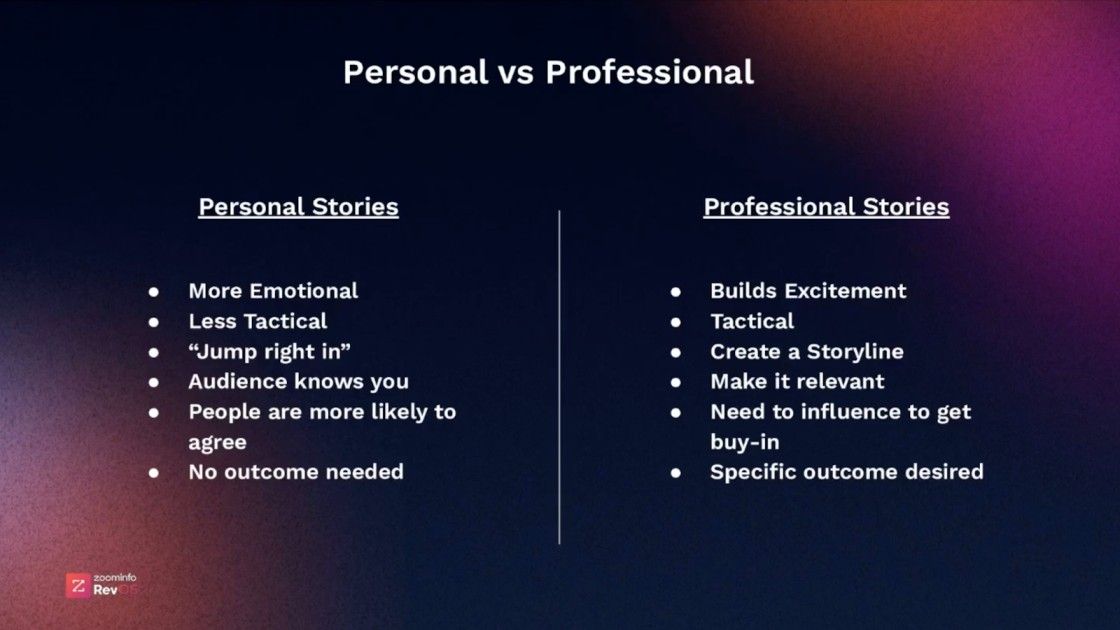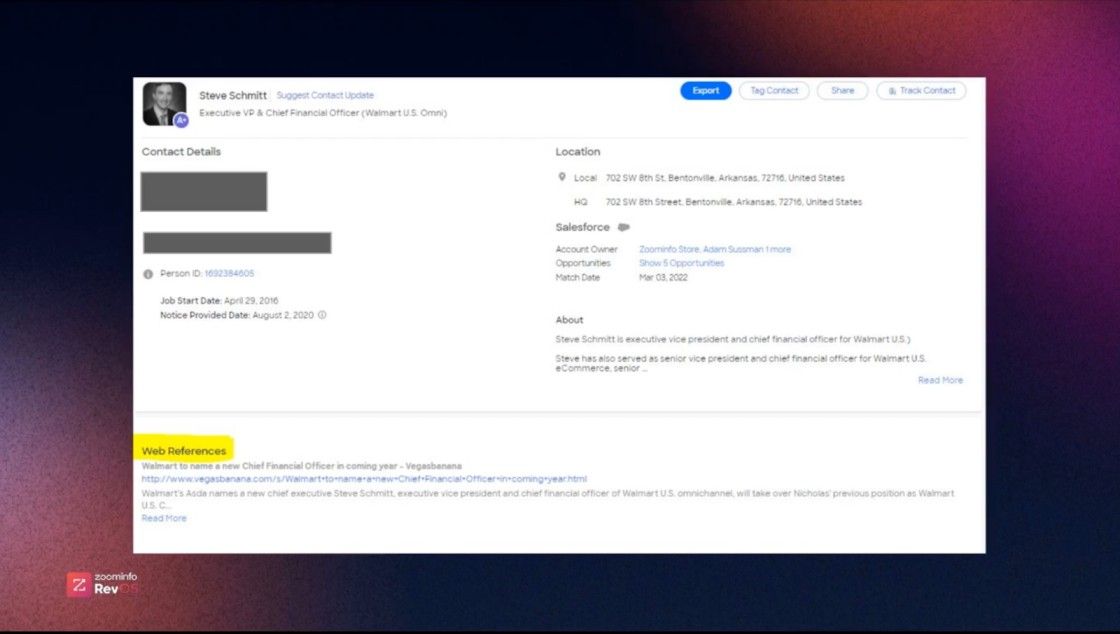This article was transcribed from a talk at the Customer Success Festival back in March 2022.
I’m going to share with you the importance of storytelling and how it can impact your day-to-day, especially within the customer success org.
I’ll start with a little bit about myself. I’m a former Four Seasons Resort Manager turned go-to-market specialist. I’m annoyingly positive, and I've helped scale ZoomInfo’s customer success team from one Customer Success Manager (CSM) to over 60. It's been quite a journey.
Before we get into it, I’d like to share a few quotes that I feel resonate with the message I want to deliver through this article.
“We are as a species, addicted to story. Even when the body goes to sleep, the mind stays up all night telling itself stories.”
- Jonathan Gottschall, The Storytelling Animal: How Stories Make Us Human (2013)
“Storytelling is about connecting to other people and helping them see what you see.”
- Michael Margolis, CEO & Founder of Get Storied
And finally, my favorite one:
“Nothing sticks in your head better than a story. Stories can express the most complex ideas in the most digestible ways.”
- Sam Balter, Director of Media Content at ZoomInfo
I want us to expand our mindset around what it means to tell a story. You can tell stories internally and externally, and they don't always have to be things that you would present at a keynote.
There are plenty of TEDx articles out there that will teach you how to tell the story – mirror your audience, create suspense, and things like that. But what I'm going to focus on is turning stories into action. I’ll give a few examples of how we've done that at ZoomInfo, and I’ll touch on a few other examples I’ve come across.

Why is storytelling important?
To me, storytelling is the ability to articulate a complex process, platform, or workflow in a way that's relevant to your audience.
Are you creating stories for every conversation you have? Think about when you’re planning a meeting with your boss. Maybe you have a new idea, or you just want to share a pain point you're dealing with.
When you're thinking about how you're going to say it to your boss, you're creating a story in your mind.
In customer success, we’re on the front lines. We're constantly advocating for product enhancements. We're constantly advocating new features to our customers to get their buy-in and hopefully an upsell. All of those situations are stories, and we as CSMs need to make sure that we’re doing our best to tell those stories whenever we have the opportunity.
When stories are told well, they drive results, they build trust, they improve your audience’s knowledge, and they cultivate relationships – I think that that's the most important piece. As a result of good storytelling, you become closer to the people that you're talking to. That's why storytelling is so important, and why I'm here to highlight it.
Personal vs. professional storytelling
Let's look at two different types of stories. First off, we have personal stories. Personal stories are things that you deal with day to day. Let's say you have a challenging day in the office. At the end of the day, you go home and you dive right into the story with your friends or spouse.
It's emotional. It's not tactical at all – you're jumping right in, and the person that you're talking to is already on your side. You're talking to them about how you're frustrated with ‘John in the office’, and they're going to agree with you; they're going to be like, “I don't like John either!”
There's no outcome because it's just a personal story. Some call it venting, some call it recapping their day, but whatever you call it, it’s a more emotional kind of story.

In the office environment, you tell professional stories. You want to use these stories to build excitement – that’s what’s going to get your audience’s buy-in. Your story has to be incredibly tactical; if not, you're not going to get the results you're looking for.
If you aren't doing a good job of creating the story, it's going to be hard to follow, it's not going to resonate, and it's not going to seem relevant. That relevancy is so important because it’s how you hook people into your idea.
While your spouse might agree that ‘John from the office’ sucks, you can’t just assume that everyone you talk to in the professional sphere is automatically going to be on your side. You need to influence people professionally when you're telling them stories.
Finally, with professional stories, we’re seeking a specific outcome. If we're pushing to get training for a group of customers, that's our desired outcome. Because of this, it's very important that we approach professional stories very differently than we approach the stories we tell our friends and spouses.
Driving adoption through storytelling
We're about to dive into some storytelling secrets that will help you boost product adoption.
I've got five tips lined up for you that I’ve learned throughout my career in customer success, and they’re going to help you take your storytelling and your product adoption to the next level.
Tip #1: Make your main point of contact’s life easier
At ZoomInfo, we’ve found that new features and tools are better adopted when our main point of contact tells their team about the update.
To get the main point of contact to do that for you, you have to win them over first. You have to let them know what's in it for them. You can do this through a combination of storytelling and making their life easier.
Let's say a new feature is being rolled out in your platform, and you want your main point of contact to send an email describing that feature to their team.
Create a storyline around why this is important. Write the email for them to send to their team. Tell them the outcome of sending this email: higher adoption and better usage of the tool, leading to a greater return on their investment.
By writing that email, you’ve made their life easier, so they're more likely to do it.

Tip #2: Use familiar language
When you’re telling these stories, it's vitally important to use familiar language.
Let’s say you're working with financial institutions. They tend to use phrases like FP&A, OPEX, EV, and so on. You want to make sure that you use these kinds of terms too whenever you’re telling them stories. That’s going to help you win their buy-in.
Tip #3: Be an advocate for your end users
When you become an advocate for your end users, you’ll end up getting feedback that your main point of contact might not even be aware of. That’s huge. It allows you to bring new knowledge to contact about paint points that their team is experiencing and drive upsells of new features or products that can help soothe that pain.
When you do this, not only are you helping your customer to succeed while also working towards that upsell, but you're making your main point of contact’s life easier by gathering data and feedback and presenting it to them in such a way that really resonates.
Tip #4: Position yourself as a consultant or an extension of their team
As well as being an advocate for your users, you want to become an expert in your customers’ workflows. That way, you’ll be able to give them much more valuable advice and you’ll naturally position yourself as a consultant or an extension of their team. I promise you it can be done.
The best emails in my inbox are the ones from a main point of contact telling me that one of my reps is like part of the family. Those are the emails that make me the happiest.
Tip #5: Highlight their business goals
If you don't know where your customer is trying to go, how can you help them to succeed? If you don't know what your users are trying to accomplish, how can you advocate for them? If you don’t know what the broader business goals are, how can you help your main point of contact understand where your product fits into those goals?
Make sure you learn what your customer is working towards, and highlight those goals in every story you tell them.

Let me tell you a story…
I have a very brief story for you about a Fortune 100 customer who held a seven-figure account with us. This customer had been telling us the entire year that they wanted to renew.
Unfortunately, three months before renewal, they were like, “Our leadership doesn't think that they're seeing the ROI they hoped for, so we’re not going to renew.” It was shocking news, especially since we knew that our end users were seeing tremendous value from the product.
So what we did was we spoke to all of their power users of our product (who, by the way, we knew were also the top performers at the company), and we got 20-second video testimonials about the features of our product they use day to day and how they changed their entire world. Then, we compiled all of those videos into a quick overview and delivered it to that company’s leadership.
The leadership was blown away. They had no idea that the people using the product loved it so much.
Because we were able to articulate how the product was used and loved and tie it to the company’s business goals, they were disarmed. They listened to us, they saw the value that these licenses were bringing and that ultimately led to an upsell.
It’s up to us as customer success professionals to take these opportunities and turn them into stories that get us where we’re trying to go with our accounts.
How to tell a compelling story
I have another story for you. Below, you can see a ZoomInfo contact profile. We're looking at Steve Schmitt – he's an executive VP for Walmart.
(I’ve highlighted Steve’s web reference below. Web references are simply articles that we’ve found online that Steve has either written or been quoted in.)

Now, that story is easy to understand, but it doesn’t really give you anything. Sure, you know what web references are now, but do you know when and how to use them? No.
Now, let me explain this to you in a different way. One of our customers was a Business Development Representative (BDR) who had been reaching out to a CEO over and over again, trying to set a meeting to close a deal. The CEO was ignoring him. He didn’t respond to a single one of the BDR’s emails.
The BDR racked his brain about how to get a response from the CEO, then he went into ZoomInfo and found these web references. In one of them, he learned that the CEO had participated in a charity triathlon for cancer. Well, it just so happened that the BDR had participated in the very same charity triathlon, so he put that in the subject line of his email, got an immediate response, and closed the deal.
Think about the two different ways that I just described web references.
One was a simple definition of what web references are and where to find them. Sure, you might have learned something, but you didn't know how you could utilize that in your day-to-day.
The second explanation, however, was much more tactical. It highlighted a common problem that a lot of us face and showed how you could solve that problem with web references.
That's what good storytelling is all about. It's about taking information and making it actionable.
Things to avoid
We’ve seen some of the dos of storytelling; now let’s look at the don’ts.
- Don’t dive right in. You always have to start with discovery questions. If you don't know about this customer and their workflow, you're not going to be able to give them a good story because you won't know how it's supposed to end. Ask those questions and learn about your customer before you start spinning your tale.
- Don’t forget to include the audience. Whenever you're telling the story of how your tool is going to be used, you have to include the users. If you're speaking to a group of BDRs, highlight how utilizing your tool will differentiate them from the rest of the BDRs who are trying to book an appointment with a certain VP or C-level contacts. You have to make your story relevant to them.
- Don’t assume you have the right solution. I learned this one through trial and error. Sometimes you hear a pain point from a customer and you just assume that you know exactly how to solve it for them. Later on, you find you went down the wrong path entirely and you have to start all over again. You can avoid this by checking your assumptions with the right discovery questions.
- Don’t give too much information at once. We've all experienced this. You're in an hour-long informational meeting, and within 20 minutes, you're done. Everything starts going over your head because you’ve already filled up on details.
Don’t do that to your audience. Read the room and make sure you understand their technical level. You can’t tell the same story to a CSM with one year’s experience as you would to a director of operations. You have to change your storylines and the way you speak based on your audience.

Key storytelling takeaways
Let’s wrap things up. If you take nothing else away from this article, I want you to take away these points:
1. Be an expert in the topic
If you don't have the answers, how can you help others with their questions?
2. Make your story inclusive and relevant
I love looping in my main point of contact. If I'm on a call with a group of people and I have an end user asking me a question, I always ask for the main point of contact’s perspective. That way, it’s a conversation as opposed to me just talking to people, and all of us learn together.
3. Tell stories internally and externally
Next time you talk to your boss, your team, or another department, make whatever you’re talking about into a story. If you talk about the pain points you're feeling, the solution you’ve come up with, why that solution will work, and the desired outcome you're looking to find, people are going to buy into whatever play you want to make.
4. Help people reach their goals
In all of my stories, the end goal is to make someone better than they were before the story. If I'm not doing that, I'm not succeeding, and I need to reevaluate the storyline. If at the end of your story or presentation, people aren't feeling inspired to try something new, you need to revise it.
5. Make your story actionable
Don’t just share information, tell your audience how to leverage it.
6. Build trust and cultivate deep relationships
When you ask the right questions and tell the right stories, not only will you become an even more valued member of your organization, but you'll become an extension of your customer’s team too, and you'll build deep relationships that will help you come renewal time.



 Follow us on LinkedIn
Follow us on LinkedIn




